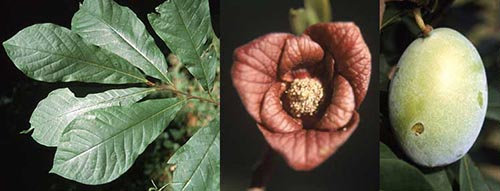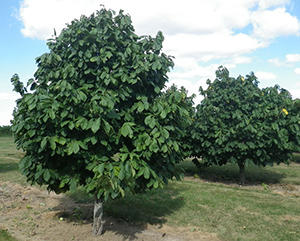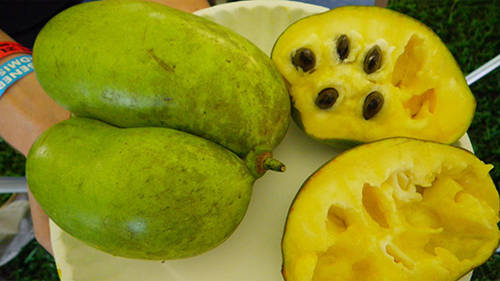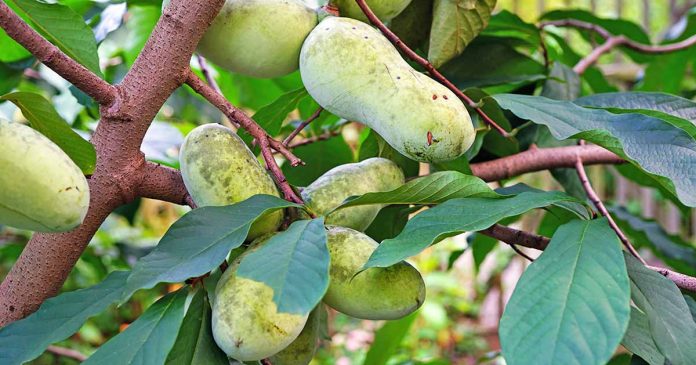The Pawpaw was cherished by Native Americans. It was easily available to them and there were many uses of it. However, despite being very useful and many of these trees still remain in the states where they are a native species, they have been largely forgotten by society at large. If in one of those states you are a prepper and pawpaws do not figure in your emergency planning, this article is for you.
What is Pawpaw?
The pawpaw tree, known as Asimina triloba in the scientific community, is a fruit-bearing tree that is nowadays more admired for its attractive foliage and blooms.
Compared to many other native trees, the tree itself is small, topping out at around 35 feet in height with a trunk between 8 and 10 inches wide. The leaves are large, they are simple and elliptically shaped, typically dark green in shiny color. The foliage turns vividly rusty yellow in fall.The flowers of the tree, which bloom in early spring are colored maroon, and six petaled. Remember that the flowers stink – the smell is also identified as rotting meat.

Pawpaw fruits begin light greenish-yellow, turn brown as they mature in late summer and early fall. They’re oblong, approximately bean-shaped, and size ranges from a few ounces to around one pound. Many people say the pawpaw fruit tastes like a mango and banana combination, and the texture is close to that of a banana as well, it feels like a thick custard a bit. The pawpaw is actually a berry, and they grow in banana-like bunches, another misclassified berry.
It’s possible that given significant historical usage and availability, the pawpaw isn’t a popular food today because it easily spoils compared to other fresh foods you find in the supermarket. At a local farmer’s market, you may be able to find freshly grown pawpaw, though, or if you live somewhere it grows in the wild, you can go foraging for it.
Why did Native Americans Love the Pawpaw?
 Just because it was pretty useful. The Iroquois ate the mashed fruit plain or either dried it whole or mixed, and made it into small cakes, and it was also a major part of the diets of many other Native American tribes. With its fibers, the Cherokee cherished the pawpaw. They used pawpaw bark to make rope and cordage for bow strings, fishing, and building. Several tribes have grounded the seeds into a powder, and used them as a louse deterrent.
Just because it was pretty useful. The Iroquois ate the mashed fruit plain or either dried it whole or mixed, and made it into small cakes, and it was also a major part of the diets of many other Native American tribes. With its fibers, the Cherokee cherished the pawpaw. They used pawpaw bark to make rope and cordage for bow strings, fishing, and building. Several tribes have grounded the seeds into a powder, and used them as a louse deterrent.
Related: How To Prepare Medicinal Pickled Garlic
Pawpaw Growing Conditions
The pawpaw looks much like a tropical plant. The large, deep green leaves, and the quality of the fruit it grows, seem to fit in with what we see as tropical fruit-bearing trees. Not withstanding that, however, pawpaw is still doing well in more temperate climates like those found in the United States.
It is mostly found in the floodplains and a few years after a forest starts to develop, it grows rapidly to form patches. Because they grow rapidly they often overtake slower-growing trees and take over an area, creating a colony of pawpaw.
Where Can You Find Pawpaw?
In the US, in what is affectionately known as the ‘pawpaw belt,’ pawpaw can be found. This covers 26 states and portions of Canada. They find themselves in the East, in the South, and in the Midwest. From New York to Florida you will find pawpaw, out to Texas and up to southern Canada.
Which Parts of the Pawpaw are Edible?

The fruit itself is edible; but you probably don’t want to eat the skin. Instead, cut the fruit in half or peel it to get within the custardy insides. Scoop it out easily and eat it clearly or apply it to any number of recipes. The seeds certainly won’t hurt you, but you do not want to eat them out of hand. Save for certain medicinal purposes, the tree itself is not much good for eating.
Pawpaw Nutritional Value
Nutritionally speaking, the pawpaw fruit is very useful. As a fruit, it is high in protein, with a serving of 1.2 grams per 3.5 ounce, plus it is a rich source of fiber. This also contains high content of vitamin C, potassium, manganese, magnesium, and iron.
Pawpaw Culinary Uses
Because of its strong taste and texture Pawpaw can be used in many recipes in place of banana. When substituted with bananas, it’s great in baked goods, and when it’s available pawpaw ice cream is very popular. This fruit can also be turned into a liquor which is exceptional to some men.
People aren’t the only ones who like pawpaw. It is a common staple in the diet of many mammals in North America, including bears, foxes and raccoons.
Related: 5 Home Remedies for Diarrhea
Other Uses for Pawpaw
Pawpaw’s not a single-trick pony. There are many uses to this tree and the fruit is not the only useful element. The seeds, bark, roots, and leaves are also used for other things.
Medicinal Uses for Pawpaw
Pawpaw extract was known to kill head and body lice, as well as other parasites. As an anti-inflammatory substance, in homeopathy, pawpaw is used to treat many conditions ranging from certain forms of cancer to mild pain, particularly in the mouth and throat. It is sometimes used for fever care and can be used to avoid vomiting. There are some early studies out there that suggests that pawpaw can be useful as a cure for the herpes simplex virus in salve form, as well.
Practical Applications
Pawpaw contains a compound which repels insects naturally, therefore, it is often used in insecticides. Despite its insecticide tendencies, in particular, there is one bug that relies solely on the pawpaw for its food and nesting area. The zebra swallowtail butterfly consumes only the pawpaw in its larval form, therefore the chemicals present in the leaves will protect them from predators.
The fibrous bark may also be used to build cordage that could be useful in a situation of survival or for craft applications. Historically, it was used for bow strings, fishing line, fishing stringers, and other purposes of trapping. Rope constructed from pawpaw’s bark may also be used to construct shelters.
If you stay in the ‘right’ half of the US, be sure that when foraging or practicing in survival strategies you don’t miss the pawpaw tree.











